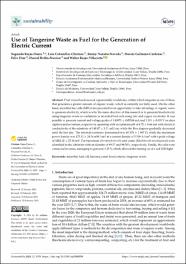“Use of Tangerine Waste as Fuel for the Generation of Electric Current“

Ver/
Descargar
(application/pdf: 1.775Mb)
(application/pdf: 1.775Mb)
Fecha
2023-02-15Autor(es)
Ortiz-Saavedra, Brando
Cabanillas-Chirinos, Luis
Nazario-Naveda, Renny
Gallozzo-Cardenas, Moisés
Diaz, Félix
Delfin-Narciso, Daniel
Rojas-Villacorta, Walter
Metadatos
Mostrar el registro completo del ítemResumen
“Fruit waste has increased exponentially worldwide, within which tangerine is one of those
that generates a greater amount of organic waste, which is currently not fully used. On the other
hand, microbial fuel cells (MFCs) are presented as an opportunity to take advantage of organic waste
to generate electricity, which is why the main objective of this research is to generate bioelectricity
using tangerine waste as a substrate in microbial fuel cells using zinc and copper electrodes. It was
possible to generate current and voltage peaks of 1.43973 ± 0.05568 mA and 1.191 ± 0.035 V on days
eighteen and seventeen, respectively, operating with an optimum pH of 4.78 ± 0.46 and with electrical
conductivity of the substrate of 140.07 ± 3.51 mS/cm, while the Brix degrees gradually decreased
until the last day. The internal resistance determined was 65.378 ± 1.967 Ω, while the maximum
power density was 475.32 ± 24.56 mW/cm2 at a current density of 5.539 A/cm2 with a peak voltage
of 1024.12 ± 25.16 mV. The bacterium (Serratia fonticola) and yeasts (Rhodotorula mucilaginosa) were
identified in the substrate with an identity of 99.57 and 99.50%, respectively. Finally, the cells were
connected in series, managing to generate 3.15 V, which allowed the turning on of a red LED light.
“
Colecciones
- SCOPUS [380]

